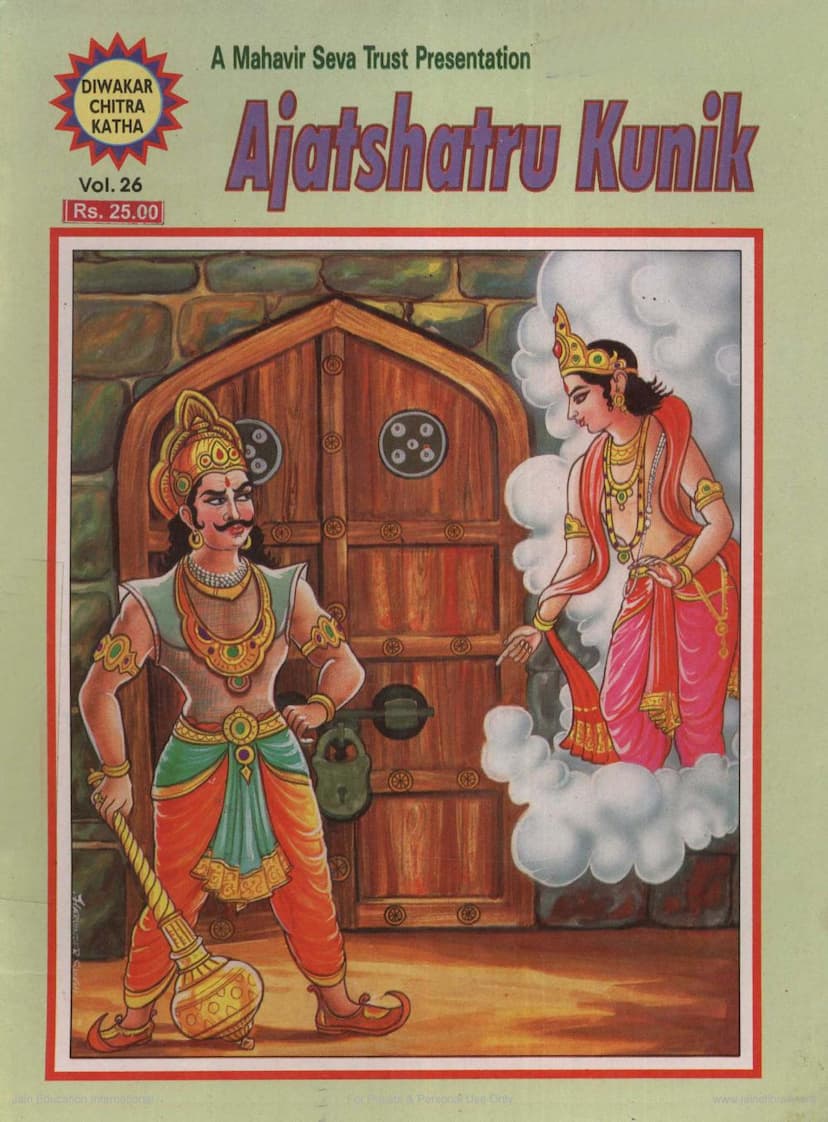Ajatshatru Kunik Diwakar Chitrakatha 026
Added to library: September 1, 2025

Summary
Here's a comprehensive summary of the Jain text "Ajatshatru Kunik Diwakar Chitrakatha 026" in English:
This comic book, "Ajatshatru Kunik Diwakar Chitrakatha Vol. 26," published by Mahavir Seva Trust Mumbai, presents the life story of Ajatshatru Kunik, a historical figure from ancient India, approximately 2500 years ago. The narrative draws from Jain sources and aims to inspire readers to control their desires and ambitions. The script is by Shri Tarun Muniji.
The book begins by highlighting that human needs are limited, but desires are boundless. Uncontrolled desires fuel ambition, which is identified as the root of conflict, bloodshed, and suffering in the world. Ambitious individuals are often devoid of religious, moral, and emotional sentiments.
The Story of Ajatshatru Kunik:
-
Ominous Birth: Kunik, originally named Ashok Chandra, was the son of King Shrenik Bimbsar of Magadh and Queen Chelna. Queen Chelna, experiencing a disturbing premonition (dohad) about her son, ordered him to be discarded on a garbage heap. King Shrenik, however, found the infant, noticed his bleeding finger (pecked by a hen, leading to the name "Kunik," meaning "one with a cut finger"), and, despite his mother's misgivings, lovingly took him in and cared for him. This early act of paternal care is contrasted with Kunik's later actions.
-
Seeds of Discontent: As Kunik grew, he felt a sense of neglect and partiality from his father, stemming from minor incidents like receiving slightly different sweets from his brothers. This fostered resentment and a feeling of dislike.
-
The Sechanak Elephant: The story introduces a significant event involving an elephant herd led by a cruel bull-elephant that killed its male offspring. A she-elephant, pregnant with a male calf, feigned lameness to escape the bull and found refuge in a hermitage. There, she gave birth to a strong male elephant, who was named Sechanak (meaning "one who waters plants") by the hermits for his habit of sprinkling water on plants. Sechanak eventually killed the cruel bull-elephant and became the leader of the herd.
-
Kunik's Ascension and Patricide: Driven by ambition and the desire for the throne, Kunik, with the help of his ten stepbrothers, arrested his father, King Shrenik. He imprisoned Shrenik and subjected him to daily physical torture, including being whipped. Queen Chelna tried to intervene and remind Kunik of his father's love and sacrifice, but Kunik remained unmoved. Tragically, King Shrenik, despairing of his son's cruelty and the thought of further torture, took poison and died before Kunik could release him. Kunik was consumed by remorse for his "heinous crime."
-
Founding of Champa and Envy: Following his father's death and driven by sadness, Kunik decided to build a new capital city called Champa. His wife, Queen Padmavati, grew envious when she saw his half-brothers, Halla and Vihalla, enjoying royal comforts and possessing valuable state assets: the Sechanak elephant and a divine eighteen-string necklace, which were gifted to them by King Shrenik. Padmavati's insistence pushed Kunik to demand these items back from his brothers.
-
The Destruction of Vaishali: Halla and Vihalla, fearing Kunik's ruthlessness (especially after he killed his father), fled to Vaishali, their maternal grandfather Chetak's kingdom. Kunik, enraged, sent an emissary to demand their return and the state property. When Chetak refused, Kunik vowed to destroy Vaishali. He waged a brutal war against Vaishali, killing his ten brothers in the process, who were fighting on his side under the command of Kaal Kumar. With divine help from Shakrendra and Chamarendra, who provided him with impenetrable armor, and powerful weapons like Mahashilakantak and Rath-musal (a tank), Kunik overwhelmed Vaishali's defenses. He fulfilled his vow by destroying the city and ordering it to be tilled with donkey-ploughs, a devastating act of revenge.
-
The Pursuit of Becoming a Chakravarti: After his victory, Kunik, fueled by pride, declared himself invincible and aimed to become a Chakravarti (universal emperor). He met Bhagavan Mahavir, who revealed that Chakravartis, despite their worldly power, are reborn in the seventh hell after death. Kunik was informed that he would go to the sixth hell, as he was not a true Chakravarti, the quota for the current cycle being full. Obsessed with the title, Kunik had replicas of the Chakravarti's fourteen divine possessions created and embarked on a victory march to establish a world empire.
-
The Tragic End: His ambition led him to the Vaitadhyagiri mountain, where the gate to a passage was guarded by an angel named Kritmal. When Kunik, calling himself Chakravarti Ashok Chandra, demanded passage, the angel informed him that he was not a true Chakravarti and that his ambition was misplaced. Enraged, Kunik attacked the gate. The angel, in self-defense, set Kunik ablaze with divine flames, reducing him to ashes. His army dispersed, and he was reborn in the sixth hell.
Moral Lessons:
The book concludes with several moral lessons:
- Consequences of Animosity: Early animosity, like Kunik's towards his father, can lead to disastrous actions. Caution and attentiveness in behavior are crucial.
- Controlling Ambition: Blind ambition can lead to mistreatment of parents. Ambitions must be controlled by reason.
- Resisting External Pressure: Jealousy and insistence from others (like Queen Padmavati) should not lead to injustice or the abandonment of morality, as seen in the destruction of Vaishali.
- The Peril of Over-Ambition and Pride: Ignoring warnings (from Bhagavan Mahavir) and succumbing to ambition, craving for pleasures, and false pride leads to destruction.
The "विशेष ज्ञातव्य" (Special Notes) section provides additional context, explaining that Kunik is also known as Ashokchandra Kunik and Ajatshatru in other traditions. It highlights his devotion to Bhagavan Mahavir, the religious background of his mother Queen Chelna and his mother's aunt Trishla (who was Bhagavan Mahavir's mother), and the significance of Vaishali. It also touches upon the previous birth of the Sechanak elephant and the eventual renunciation of Halla and Vihalla.